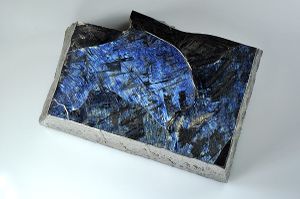Titanium
Titanium is the 22nd element on the periodic table of elements and it is the ninth most abundant element on Earth.[2] Some of its properties are listed below:[2]
| Atomic weight | 47.867 |
| Density (at 0oC) | 4.506 g/cm3 |
| Boiling point | 3560 K |
| Melting point | 1943 K |
Titanium is a transition metal. It is found primarily in igneous rocks, but can also be found in sedimentary and metamorphic rock derived from igneous sources. Titanium is a very useful metal due to its high strength, low density, and low reactivity.[2]
Titanium Uses

Titanium is used to create alloys with many other metals because it is as strong as steel while having a lower density (Figure 2). Titanium alloys are popular for making any flying (aerial or space) machines where lightweight and heat resistant properties are useful.It is also popular for everyday items like automotives, bicycles, medical and sports equipment, and portable electronics. Titanium's low reactivity and its ability to connect well with bone makes it ideal for surgical implants and replacements. Low reactivity also means it is resistant to corrosion, making it useful for an applications where sea water is involved. Titanium also excels at reflecting infrared and ultraviolet radiation, making it useful for space observatory equipment that might be sensitive to radiation and also as a sunscreen for protecting skin. Titanium(IV) oxide is bright white in colour and its durability makes it good for paint, enamels, and plastic.[4]
Power Plants and Nuclear Waste Storage

Titanium's mechanical and chemical properties make it an ideal metal for power plant condenser pipes and nuclear waste storage (Figure 3).
Titanium allows power plant condenser pipes to be strong, lightweight, corrosion resistant, and thinner (which allows for better heat transfer). This all adds up to pipes that easier to maintain, more efficient, and last longer than pipes made from other metals. Other metals and materials typically last 20 years, while titanium pipes have an average lifespan closer to 40 years.[6]
Many of the properties that make titanium ideal for power plant condenser pipes also make it an ideal metal nuclear waste storage containers. The most important property for a nuclear waste storage container material is low reactivity with other substances or, in other words, high corrosion resistance. This means that the material cannot be easily broken down, which is vital to storing nuclear waste and preventing leaks. Titanium can also be used to design nuclear reactor shields. Shields go around the reactors and help to increase the lifespan of the reactor as well as the safety of the operation.[7]
Isotopes
Titanium has five isotopes found in nature:[2]
| Symbol | Natural Abundance |
|---|---|
| 46Ti | 8.25% |
| 47Ti | 7.44% |
| 48Ti | 73.72% |
| 49Ti | 5.41% |
| 50Ti | 5.18% |
Video
The video below is from the University of Nottingham's periodic videos project.[8] They have created a complete suite of short videos on every element on the periodic table of elements.
For Further Reading
- Periodic table of elements
- Metal
- Power plant
- Nuclear power
- Or explore a random page
References
- ↑ Made internally by a member of the Energy Education team, with information from periodictable.com, Available: http://periodictable.com/Elements/001/index.html
- ↑ 2.0 2.1 2.2 2.3 Royal Society of Chemistry Periodic Table, Titanium [Online], Available: http://www.rsc.org/periodic-table/element/22/titanium
- ↑ WikiMedia Commons, This is a file from the Wikimedia Commons File:Hochreines Titan (99.999) mit sichtbarer Kristallstruktur.jpg, Accessed on: Oct. 9, 2018. Available: https://en.wikipedia.org/wiki/File:Hochreines_Titan_(99.999)_mit_sichtbarer_Kristallstruktur.jpg
- ↑ John Emsley, "Nature’s Building Blocks: An A-Z Guide to the Elements", Oxford University Press, New York, 2nd Edition, 2011.
- ↑ WikiMedia Commons, Titanium Products, Accessed on: Oct. 9, 2018. Available: https://en.wikipedia.org/wiki/File:Titanium_products.jpg
- ↑ Chapman, R. and McGowan, W, , "Titanium Trends", The Tube & Pipe Journal, March 2009. Accessed: Oct 9, 2018. Available at: https://www.thefabricator.com/article/tubepipefabrication/titanium-trends.
- ↑ F. Hua, K. Mon, P. Pasupathi, G. Gordon, D. Shoesmith, "A Review of Corrosion of Titanium Grade 7 and Other Titanium Alloys in Nuclear Waste Repository Environments", Corrosion journal, V.61 (10), June 2004. Accessed: Oct 9, 2018. Available at: http://corrosionjournal.org/doi/10.5006/1.3280899?code=NACE-prem-site
- ↑ See more videos from the University of Nottingham on different elements here: http://www.periodicvideos.com/


